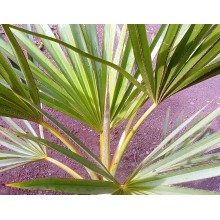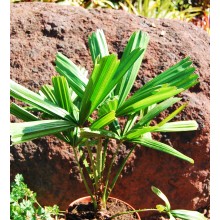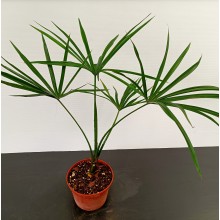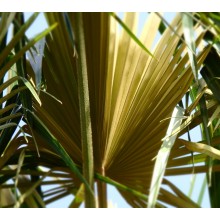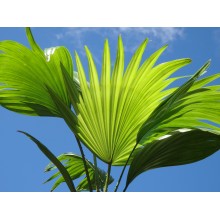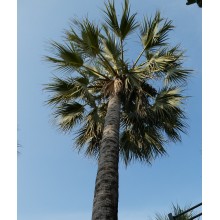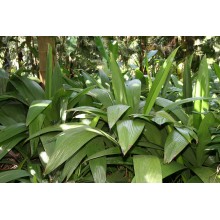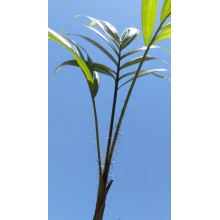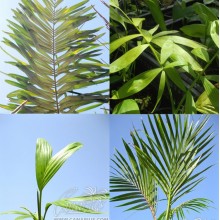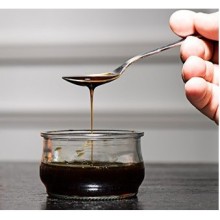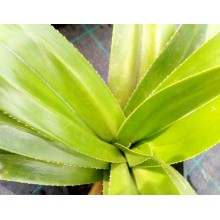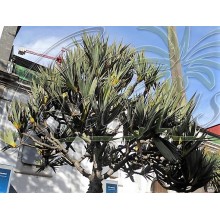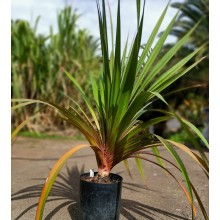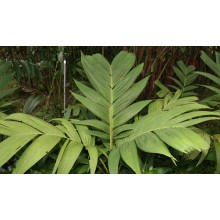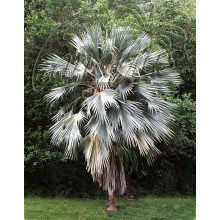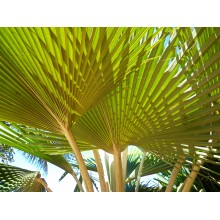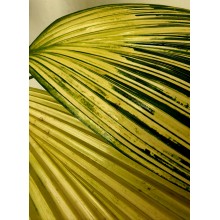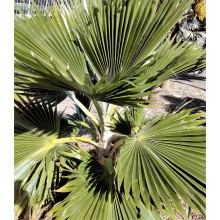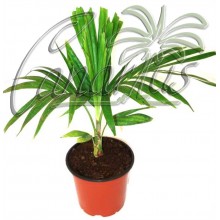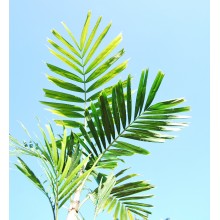Palmeras Hay 101 productos.

La familia de las palmeras, Arecaceae o Palmae, incluye cerca de 2.400 especies, nativas de climas cálidos del mundo, que van desde las delicadas especies tropicales a las palmeras resistentes al frío. Algunas palmas se pueden plantar al aire libre en Europa Central y aguantan fuertes heladas, muy por debajo de los -10 ºC (14 F). Los residentes en los países mediterráneos pueden cultivar un mayor número de especies en el exterior. Algunos cultivadores en la costa sur de Europa están criando colecciones de palmeras al aire libre que incluyen más de 100 especies.
Canarius sólo le enviará palmeras robustas, que se cultivaron en macetas pequeñas para reducir los costos de envío y problemas de preparación. Por ello, trasplántelas a macetas más grandes poco después de recibir el paquete. Esté preparado para darles lo mejor. Algunas palmeras pueden resistir nevadas, algunas pueden vivir en el interior o en macetas, y algunas son muy tropicales. Sólo tiene que elegir una que pueda prosperar en sus condiciones.
¿Qué palmeras pueden crecer en su área? Lea nuestra lista de palmeras resistente al frío para Europa. Visite el blog de Canarius y aprenda más acerca de nuestras palmeras. Verá fotos de los viveros: diferentes tipos de palmeras de Nueva Zelanda, Palmas botella con raíces de calidad superior.
-
Latania verschaffeltii LARGE
Latania verschaffeltii LARGE
Yellow Latan Palm. Yellow colour is eyecatchy juvenile palms, as they can turn very yellow, especially in cool sunny weather.
49,30 € -
Licuala spinosa
Licuala spinosa
This is the hardiest species in the genus Licuala, resistant to drought, wind, coastal conditions and short light frosts. It is a clumping palm from SE Asia. Its leaves are fantastic, glossy pinwheels.
72,00 € -
Livistona benthamii
Livistona benthamii
This species is smaller than other livistona, with glossy drooping segments, reminiscent of the more common, and much larger, Livistona decora.
43,00 € -
Livistona fulva
Livistona fulva
Livistona fulva is a palm species, restricted in distribution to the Blackdown Tablelands in central Queensland, Australia. Livistona fulva is a tall solitary palm. In nature, it grows in open forests; in cultivation. it prefers a warm temperate climate and sunny position.
26,60 € -
Medemia argun
Medemia argun
Rare palm from the desert of Sudan and Egypt. Medemia is a relative of Bismarckia and bears elegant grey-blue arching leaves. It was considered extinct in the wild until its rediscovery in the 90's. It is still hard to find ...
48,00 € -
Molineria capitulata - Palm Grass (Curculigo capitulata)
Molineria capitulata - Palm Grass (Curculigo capitulata)
Ornamental palm-like herbaceous plant from SE Asia to Australia. Palm-grass grows in bright shade and creeps as a tall ground cover, with very showy ribbed leaves, resembling the juvenile foliage of so many palms, like Syagrus romanzoffiana.
25,44 € 31,80 €¡Precio rebajado! -
Oncosperma tigillarium
Oncosperma tigillarium
Everybody wants one of these palms, but few can afford to grow one to total maturity. Oncosperma palms become the most supreme landscaping specimens, with many tall slender stems and wildly exotic drooping leaves, with thousands of spines.
52,00 € -
Pack - Palmeras pinnadas subtropicales
Pack - Palmeras pinnadas subtropicales
No todas las palmeras son tropicales. Algunas de estas especies provienen de áreas subtropicales e incluso, soportan temperaturas frías. Estas especies son palmeras pinnadas (hojas en forma de pluma) y pueden crecer en zonas donde las heladas son poco frecuentes. Proponemos algunas de estas especies: Chamaedorea flotschiana, Allagoptera caudescens,...
63,33 € 74,50 €¡Precio rebajado! -
Palm Honey - Phoenix canariensis syrup
Palm Honey - Phoenix canariensis syrup
Palm Honey or Palm Syrup is an edible sweet syrup produced produced in the Canary Islands from the sap of the native palm tree, by tapping the tree in a sustainable way. It is thinner and darker than bee-honey. Bo th are natural sweeteners, but there is a big difference in taste and content. Try it on Desserts, Fresh Cheese, Liqueurs, or Sweetener for Tea.
19,40 € -
Pandanus dubius
Pandanus dubius
This is one of the most ornamental species in the genus Pandanus. Leaves are very wide, deeply plicated with moderate spines and a drip-tip appendix. All is very elegant, of a deep and glossy green.
46,50 € -
Pandanus utilis
Pandanus utilis
Palm-like tree of unreal architecture, native to Madagascar and Mauritius. A symbol of tropical gardening.
56,00 € -
Pandanus utilis Large
Pandanus utilis Large
Palm-like tree of unreal architecture, native to Madagascar and Mauritius. A symbol of tropical gardening. Long specimen with 6cm of diameter and 1,1 meters long.
92,60 € -
PInanga coronata 'Kuhlii'
PInanga coronata 'Kuhlii'
Very ornamental and colourful small clumping palm from SE Asia. Leaves and sheaths have different shades of green, mottled with yellow. The young new leaf is mottled in red-maroon.
35,20 € -
Pritchardia hillebrandii 'Blue Moon'
Pritchardia hillebrandii 'Blue Moon'
Compact, silvery-blue form of Pritchardia hillebrandtii, with black fruits, originated in a small islet in Hawaii. Please be patient, this plant will not show any blue until late.
34,70 € -
Pritchardia minor
Pritchardia minor
This is the smallest of all Pritchardia species! It is endangered and native to the island of Kauai, at 500-1300 m elevation, so it is able to grow in cool conditions.
42,00 € -
Pritchardia remota 'Variegata'
Pritchardia remota 'Variegata'
Prithchardia remota comes from a very harsh island in Hawaii and it is possibly the best for mediterranean conditions. This year we have spotted a few variegated Pritchardias in a batch of P. remota. h= 70 cm
112,20 € 132,00 €¡Precio rebajado! -
Pritchardia thurstonii
Pritchardia thurstonii
Pure beauty lives in this small to medium sized fan palm. Leaves are beautifully stiff and plicated as in an accordeon. Fruits are held in small bunches hanging on long, arching rachis. This palm grows wild in the most remote islets in the pacific.
29,30 € -
Ptychosperma elegans
Ptychosperma elegans
This is one of the most classic and beautiful mid sized palms, from Australia. They are "elegant" in all their parts, just as their name says.
34,70 € -
Ptychosperma macarthurii
Ptychosperma macarthurii
Popular clumping palm in tropical and suptropical countries. Ptychosperma macarthurii is native to NE Australia and New Guinea.
72,00 €
En estos momentos tenemos pocos productos en esta categoría Palmeras

















